During COVID-19, the arts sector faced huge economic losses, but it also sparked rapid digital innovation. Artists and institutions turned to virtual exhibitions, online performances, and social media to stay connected and engage audiences globally. Market shifts increased online sales, and new ways for artists to showcase work emerged. If you want to explore how resilience and creativity transformed the arts during this crisis, there’s plenty more to discover ahead.
Key Takeaways
- The COVID-19 pandemic prompted a rapid digital shift in arts, with increased online exhibitions, sales, and virtual engagement.
- Artists and institutions adopted hybrid models, combining in-person and virtual experiences to maintain audience connection.
- Despite economic losses, the arts sector demonstrated resilience through innovation, community participation, and digital transformation.
- Virtual platforms enabled new forms of artistic collaboration, audience interaction, and accessibility during restrictions.
- Future strategies focus on integrating digital tools for sustainable, inclusive, and adaptable creative practices post-pandemic.
The Economic Toll on the Arts Sector
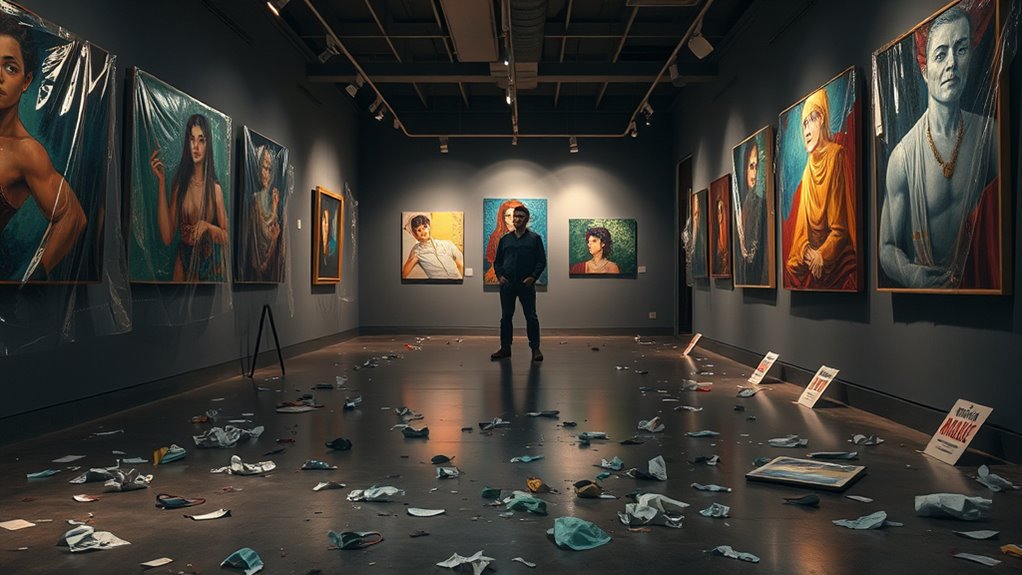
The COVID-19 pandemic has taken a heavy toll on the arts sector’s economy, causing widespread financial losses that continue to affect organizations and artists today. Restrictions on gatherings cut into revenue from live performances and exhibitions, leading to a loss of billions of dollars nationwide. For example, Chicago alone faced an estimated $4.7 billion loss up to July 2020. Many arts organizations had to tighten budgets and lay off staff, while smaller and independent artists struggled with reduced income and increased competition. Employment within the sector dropped from 5.2 million pre-pandemic to 4.6 million in 2020, with a slow recovery to 4.9 million in 2021. These economic challenges highlight the sector’s vulnerability and the importance of ongoing support. Data collected through the impact dashboard also indicates that localized impacts vary significantly across regions, underscoring the need for targeted assistance. Recognizing the economic toll on the arts sector underscores the urgency for innovative funding solutions and community engagement strategies.
Digital Transformation and Innovation

How has the COVID-19 pandemic accelerated digital transformation in the art world? It pushed galleries to move online quickly, increasing digital initiatives and boosting online sales from 10% in 2019 to 37% in early 2020. Virtual events and online platforms became essential for art fairs and auctions, helping galleries reach broader audiences and stay afloat. Major auction houses like Sotheby’s and Christie’s adopted online, livestreamed, hybrid formats, making sales more transparent and accessible globally. This shift also attracted new buyers, with 26% of online sales in mid-2020 from newcomers, while 74% came from existing clients. The pandemic also prompted many galleries to reevaluate their organizational resources and digital strategies, leading to a more integrated approach. Digital tools enhanced marketing, transparency, and immersive experiences, ensuring the art world’s resilience and paving the way for ongoing digital evolution. Additionally, the use of digital projection and virtual reality technologies has expanded, offering innovative ways to experience art remotely and enhancing audience engagement. The integration of art analytics and data-driven marketing further optimized sales and audience targeting, strengthening digital initiatives. Moreover, implementing Quality Assurance best practices in digital platforms can help maintain high standards and build trust among users, ensuring a sustainable digital presence. Embracing digital innovation has become a key factor in adapting to the new normal and fostering long-term growth in the art industry. As the digital landscape continues to evolve, the importance of digital literacy among art professionals is increasingly recognized to maximize these technological advancements effectively.
Artists’ New Avenues for Engagement
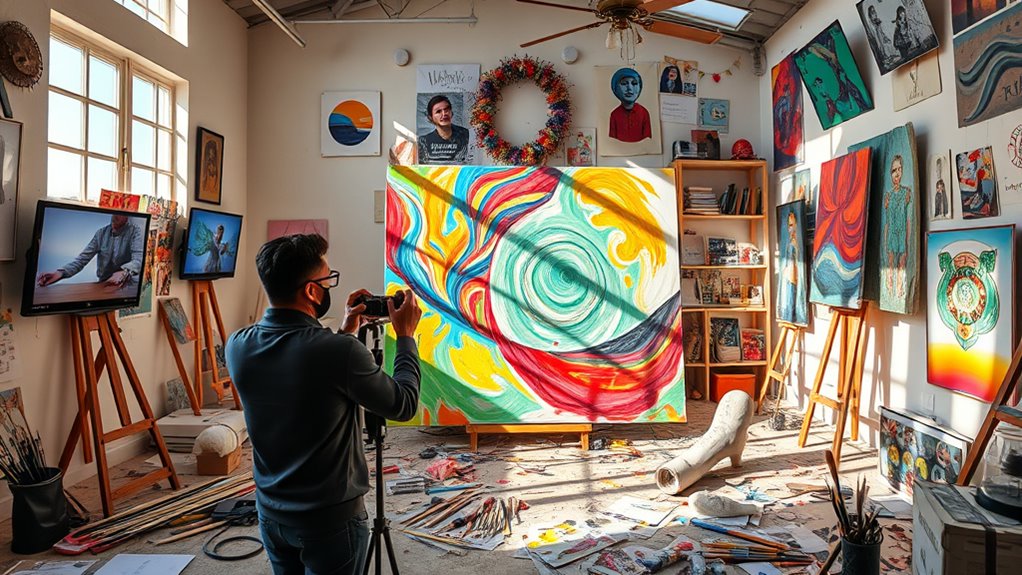
During the pandemic, artists turned to online performances and livestreams to stay connected with audiences, overcoming the limitations of physical venues. You can now attend concerts, theater shows, and art events from anywhere, often supporting artists through digital donations or tips. Hybrid models combine live and digital elements, increasing participation and interaction, like real-time Q&As or digital meet-and-greets. Artists also led virtual workshops and masterclasses across disciplines, reaching diverse audiences globally while fostering community through personalized feedback. Social media platforms became hubs for collaboration, with challenges and hashtags encouraging user-generated content and viral sharing. Crowdsourced projects and interactive virtual galleries invited participation, addressing pandemic themes. These new avenues let you engage directly with art, supporting creators and strengthening community bonds during challenging times. This shift in engagement methods has also been shown to improve mental well-being by providing creative outlets during stressful periods.
Market Shifts and Changing Buyer Behaviors
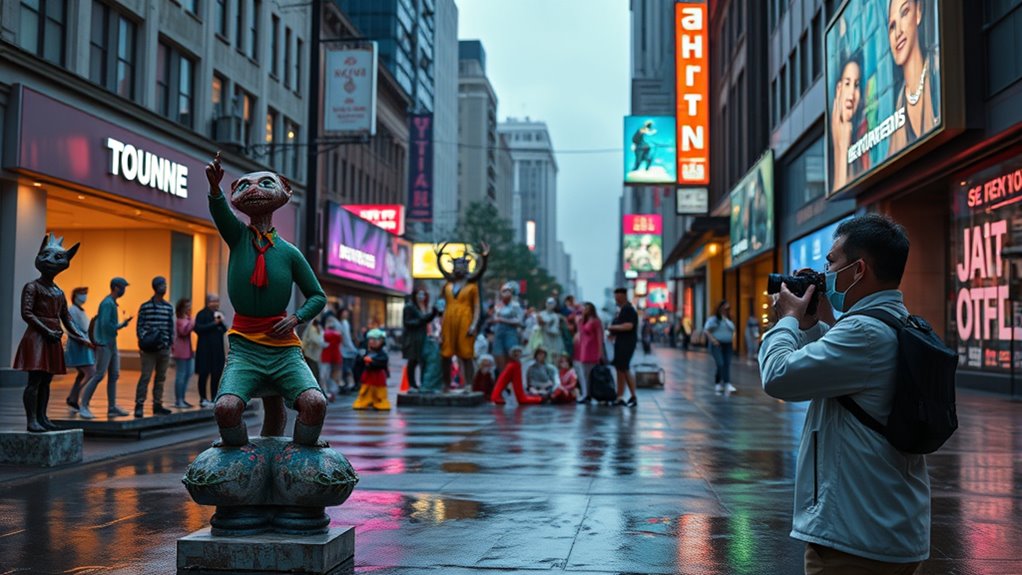
As the art market evolves, shifts in buyer behaviors and market dynamics have become clear indicators of change. Despite a 22% drop in global sales in 2020, the market remained above recession lows, with the US dominating at 42% of sales. Online sales surged, doubling in value during 2020 and stabilizing at 18% of the market by 2024, attracting younger, digitally savvy buyers. Auction houses embraced virtual formats, increasing buyer engagement and expanding reach. Collectors showed increased interest during the pandemic, with many making multiple purchases despite fewer in-person opportunities. Buyers now seek more affordable works, boosting smaller dealers and volume sales. The younger demographic’s online engagement signals a lasting shift, shaping future market trends and buyer preferences. Digital adoption in the art market continues to accelerate, influencing how collectors discover and acquire art. Additionally, the adoption of technological tools like virtual viewing rooms and online bidding platforms has further transformed the buying experience, making art more accessible to a global audience. Furthermore, the integration of market analytics has allowed sellers to better understand emerging trends and tailor their offerings accordingly. Moreover, the increased use of digital marketing strategies has helped artists and galleries reach wider audiences and adapt to changing consumer behaviors. Emerging technologies are also enabling more immersive and interactive art experiences, further engaging buyers in a digital environment. This ongoing digital transformation highlights the importance of adaptability for art market participants seeking to thrive in a rapidly changing landscape.
Challenges and Resilience of Cultural Institutions
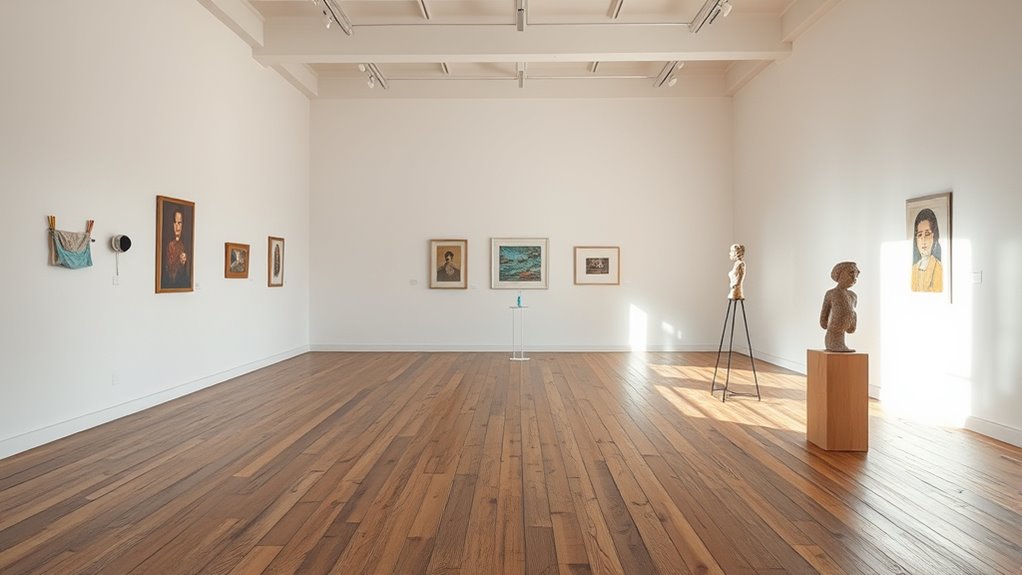
You face the challenge of how cultural institutions adapt amid financial struggles and changing public support. Many have turned to digital platforms and community efforts to stay connected, but funding remains a constant hurdle. Exploring how these strategies build resilience can reveal the future of arts and culture in uncertain times. Impact of COVID-19 on Cultural and Creative Industries Globally, with a contribution of 3.1% to the global GDP in 2020 and the loss of approximately 6.2 million jobs, underscores the magnitude of these challenges and the urgent need for sustainable funding models.
Digital Transition Strategies
Cultural institutions faced significant challenges when shifting to digital platforms amid the pandemic, but they also demonstrated remarkable resilience and innovation. You saw museums quickly expand their online presence, with UNESCO documenting over 600 digital initiatives worldwide. Industry reports revealed efforts to sustain these changes post-pandemic, emphasizing digital continuity. However, many struggled with economic constraints, technological barriers, and staff training, requiring investments in digital infrastructure and content creation. Despite these hurdles, institutions collaborated through professional organizations, using platforms like Google Classroom and Zoom to engage audiences. They expanded social media, digitized collections, and developed new evaluation methods based on audience feedback. Additionally, incorporating natural materials and maintaining a cozy atmosphere can help foster a sense of comfort and authenticity in virtual exhibitions and educational content. To enhance engagement, some institutions experimented with interactive features, encouraging audience participation and feedback. Developing effective digital strategies also involved addressing issues such as access disparities and digital literacy among audiences. Furthermore, leveraging the power of visualization can help audiences better connect with virtual content and improve their overall experience. Many institutions also explored culturally relevant themes to make digital content more relatable and engaging for diverse audiences. Moving forward, you’ll find continued focus on digital strategies, hybrid models, and incorporating innovative tech to ensure long-term engagement and adaptability.
Community Engagement Efforts
The shift to digital platforms during the pandemic opened new avenues for community engagement, but it also revealed significant challenges. You might have seen increased digital arts consumption, with 82% of adults engaging online from 2021 to 2022. Community-based arts, music, and theatre fostered informal mutual aid, supporting mental and physical health. Despite these efforts, public participation in cultural events declined sharply, and many organizations faced workforce cuts, furloughs, and revenue losses. Yet, over 70% of cultural institutions continued operating, adapting services to online or remote formats. These efforts strengthened social bonds, promoted cultural diversity, and created informal support networks, demonstrating resilience amid adversity. Additionally, Kwatsjpedia highlights how innovative materials and digital collaborations have been instrumental in evolving the artistic landscape during crises. The importance of creative practice was underscored as communities sought new ways to express and connect despite restrictions. Furthermore, the integration of digital tools enabled artists and institutions to reach broader audiences and maintain engagement during periods of physical distancing. Leveraging AI content clusters can further enhance community outreach by creating targeted, interconnected content that resonates with diverse audiences. Incorporating necessary cookies can improve user experience and facilitate personalized engagement, especially in digital environments. Your community’s engagement efforts played a crucial role in recovery, even as challenges persisted.
Financial Support Challenges
Despite the resilience shown by many arts organizations during the pandemic, financial support challenges remain a major hurdle. You’ve seen revenue drop sharply—$95.9 million across 121 organizations, with earned income plummeting by $131.6 million. Nonprofits lost nearly $18 billion, and local businesses suffered an additional $17.6 billion in audience-related spending. Although public funding and donations increased by $35.7 million, they didn’t fully offset the losses, leaving budgets strained. Workforce reductions hit 41% of organizations, risking long-term talent loss. Many had to pivot to digital, but new operational costs added pressure. Overall, public participation remains low, and revenue recovery is uncertain, making ongoing financial support vital for cultural institutions’ survival and future growth.
The Rise of Online Sales and Virtual Exhibitions
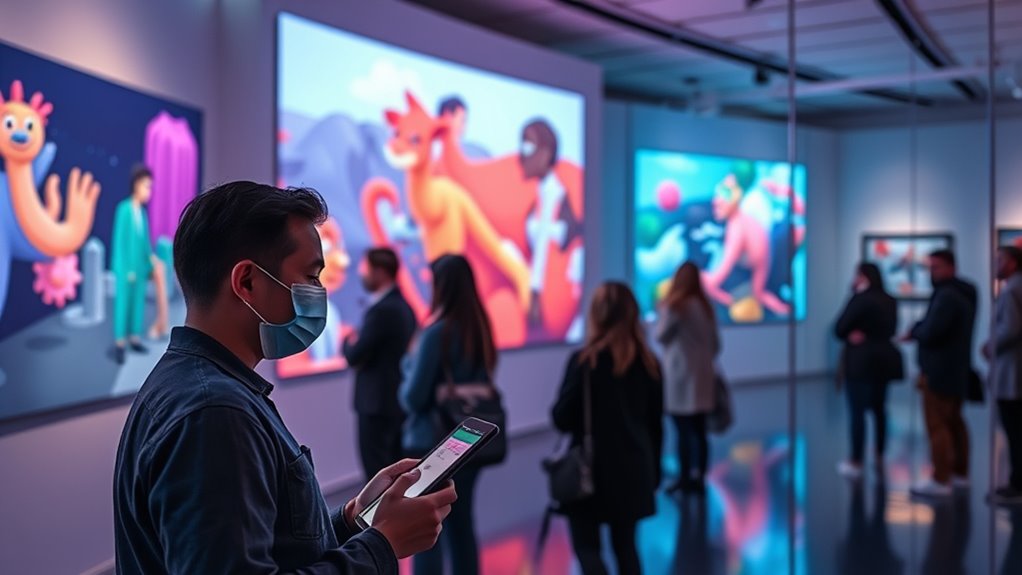
The pandemic transformed how you experience and purchase art, with digital reach expanding rapidly. Virtual exhibitions now offer innovative ways to engage and connect with artworks from anywhere in the world. These changes have made the art market more accessible and dynamic than ever before.
Digital Reach Expansion
As the COVID-19 pandemic forced galleries and museums to close their doors, many rapidly expanded their digital presence to reach audiences online. You’ll notice how online sales surged, with the share rising from 10% in 2019 to 37% in 2020. Major galleries with high turnover saw online sales grow fivefold, and some new buyers became comfortable purchasing art digitally. The online art market hit $14.38 billion in 2022 and is projected to reach $23.79 billion by 2030. Additionally, museums increased social media activity by over half, offering virtual exhibitions and detailed online inspections. You can also explore:
- The rise of online sales channels.
- Growth of virtual exhibitions.
- Engagement of younger and new collectors online.
Innovative Virtual Experiences
Have you noticed how virtual exhibitions and online sales transformed during the pandemic? Museums and galleries quickly adapted, creating immersive virtual experiences that expanded access worldwide. Online art sales surged, with some platforms reporting a six-fold increase in 2020’s first seven months. Major auction houses hosted successful virtual sales, breaking records—Sotheby’s, for example, generated $363.2 million. Artists and curators embraced immersive tech like virtual reality to enhance engagement. Virtual platforms broadened the global audience, making art more accessible than ever. Digital marketing helped galleries reach wider audiences, while online participation skyrocketed—82% of arts consumers engaged digitally between 2021 and 2022. This shift not only sustained the art world but also reshaped how we experience and buy art, signaling a lasting evolution in the industry.
Long-Term Impacts and Future Opportunities
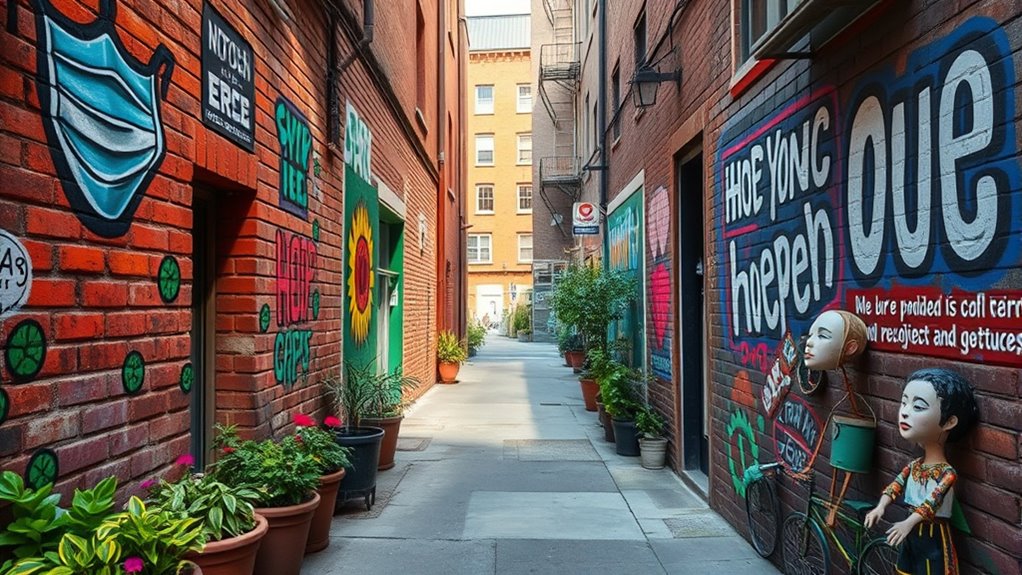
Long-term impacts of the COVID-19 pandemic are reshaping the arts sector’s landscape, revealing both challenges and opportunities. You’ll see that economic losses, like over $3.2 billion for nonprofits and 600,000 jobs lost, highlight the sector’s struggles. However, digital transformation offers new avenues for growth. Here are key opportunities:
- Expanding digital access: Nearly 79% of organizations plan to improve digital programming, reaching broader audiences worldwide.
- Hybrid formats: Over half expect to adopt hybrid or new digital formats, blending in-person and virtual experiences.
- Audience engagement: Changing consumer preferences favor virtual and personalized interactions, encouraging arts organizations to diversify offerings.
These shifts can foster resilience, economic recovery, and more inclusive cultural participation moving forward.
Frequently Asked Questions
How Did Government Policies Support Arts Recovery During COVID-19?
You see that government policies played a pivotal role in supporting arts recovery during COVID-19. They provided significant funding through the American Rescue Plan and Fiscal Recovery Funds, making cultural organizations eligible for federal relief. These policies enabled local governments to distribute funds directly to arts organizations, helping them adapt with digital strategies and safety measures. Your arts community benefited from this support, fostering resilience and innovation in challenging times.
What New Skills Are Essential for Artists in the Digital Age?
Imagine you’re a digital artist in the 21st century, where new skills are essential. You need strong drawing fundamentals, a good grasp of color theory, and proficiency with tools like Photoshop or Procreate. You should also master storytelling, adapt to trends, and understand digital marketing. Plus, embracing AI tools and experimentation keeps you innovative. Staying updated and collaborating remotely are key to thriving in today’s ever-evolving digital art landscape.
How Sustainable Are Online Art Markets Long-Term?
You might wonder if online art markets will last long-term. Currently, they show strong growth, driven by technological innovations, broader access, and changing collector behaviors. However, challenges like market volatility, authenticity concerns, and maintaining traditional relationships remain. If you adapt by prioritizing trust, balancing digital and in-person experiences, and leveraging new tools, you can help guarantee the sustainability of online art markets in the future.
What Role Did Community Engagement Play in Arts Resilience?
Community engagement plays a essential role in arts resilience by fostering connections and support networks, even when in-person interactions aren’t possible. You adapt by using digital platforms for virtual events and collaborative projects, ensuring ongoing participation. This approach keeps communities involved, maintains interest, and promotes inclusivity. By prioritizing accessibility and emotional support, you help the arts sector bounce back stronger, demonstrating resilience through innovation and collective effort.
How Will the Pandemic Influence Future Arts Funding and Investment?
The pandemic has made it clear that arts funding needs to be bulletproof. You’ll see a shift toward more stable, long-term investments focused on digital tech, workforce support, and infrastructure upgrades. Funding priorities are likely to favor community-centered projects and data-driven results. While the sector may face hurdles, adapting strategies now can help safeguard arts organizations from future storms, turning challenges into opportunities for growth and resilience.
Conclusion
As the pandemic reshapes the art world, you’ll find creativity blooming like a phoenix rising from ashes. Digital tools become your new palette, opening doors to endless virtual galleries and innovative ways to connect. Though challenges cast shadows, resilience fuels your journey forward. Embrace these shifts as a canvas for growth, turning crisis into a masterpiece of opportunity. Your artistic spirit can flourish, painting a brighter future amid the uncertain winds of change.








